Understanding the Zesterra Equine Tub for Horse Care
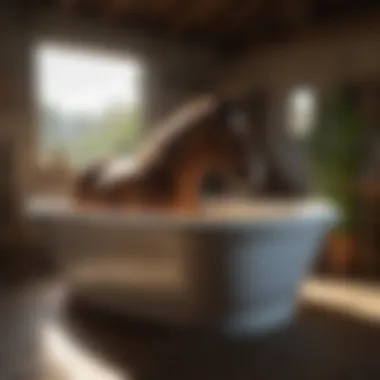

Intro
The advent of specialized tools for equine care marks a significant evolution in the management of horses. Among these tools, the Zesterra equine tub has gained particular attention for its innovative approach to hydration and feed management. Understanding how this product operates and its implications can greatly benefit those involved in horse care.
In this article, we will investigate the key aspects of the Zesterra tub, focusing on its features and practical applications. This will not only enrich your knowledge but also enhance your ability to implement effective horse management strategies.
Prelims to Zesterra Equine Tub
The Zesterra Equine Tub holds significant relevance in the field of equine care and management. This specialized tool aims to revolutionize how horse owners and caretakers approach hydration and feeding strategies. Its innovative design addresses some of the challenges faced in traditional equine management. By understanding the Zesterra Equine Tub, professionals in agriculture can enhance the well-being of horses significantly.
Definition of Zesterra Equine Tub
The Zesterra Equine Tub is a device specifically designed to promote hydration and nutrient intake for horses. It serves as a multifunctional tool that facilitates easy access to water and feed. The tub can be integrated into various management systems, promoting better health outcomes. Its structure allows for both water and feed to be maintained at optimal conditions, ensuring that the horse's dietary needs are met consistently.
Historical Context
Historically, the management of horse hydration and feeding has evolved considerably. Early approaches relied heavily on simple troughs and hay feeders, which often failed to cater to specific needs. Over time, the equine industry saw the introduction of more sophisticated systems. However, many still had limitations regarding efficiency and hygiene. The Zesterra Equine Tub marks a pivotal advancement in this long journey, reflecting both technological improvement and a deeper understanding of equine health requirements.
The development of the Zesterra Tub is indicative of modern demands within the agriculture sector. As equine care knows more about the importance of hydration and nutrition, it has prompted innovations aimed at improving horse welfare. The Zesterra Tub stands as a testament to this ongoing evolution, offering practical solutions to age-old challenges.
Design and Features
Understanding the design and features of the Zesterra equine tub is crucial for grasping its significance in equine care. This section focuses on various aspects of the tub’s construction, including its material composition, dimensions, and ergonomic design. Each element plays a role in the usability and effectiveness of the tub in real-world applications.
Material Composition
The Zesterra equine tub is composed of high-quality materials that ensure durability and longevity. The primary material used is a type of reinforced plastic, which is both lightweight and resistant to the elements. This material choice is particularly advantageous as it withstands various weather conditions, minimizing wear and tear. The easy-to-clean surface is also essential for maintaining hygiene, which is a top concern in equine management.
In addition to being durable, the choice of materials is non-toxic, ensuring it is safe for horses. This is vital as any harmful substances can lead to health issues in the animals. Moreover, this type of plastic is often designed to be UV-stabilized, preventing degradation from exposure to sunlight. The blend of strength and safety in materials ultimately influences the tub's efficiency and effectiveness in everyday use.
Dimensions and Capacity
The dimensions of the Zesterra equine tub are thoughtfully designed to cater to the needs of different equine sizes and breeds. Generally, the tub is available in multiple sizes, offering options that can accommodate both smaller ponies and larger horses.
A typical dimension might be around 48 inches in diameter, with a depth that allows for ample water and feed capacity. The wide opening allows easy access for horses while ensuring the contents remain securely inside. This design also considers the comfort of the horses, as they can drink or eat without straining.
The capacity of the tub is another critical aspect, often ranging from 10 to 20 gallons. This ample capacity reduces the need for frequent refills, which is especially beneficial during hot weather or for multiple horses. The spacious design encourages better hydration and feeding practices as horses have a greater volume of accessible resources.
Ergonomic Considerations
Ergonomic design is another key feature of the Zesterra equine tub. The tub's height is optimized for comfort, reducing the strain on horses when they are eating or drinking. This thoughtful construction helps prevent neck and back injuries, promoting overall well-being.
Additionally, the design includes rounded edges, which not only contribute to safety but also ease of cleaning. The smooth surface means there are fewer crevices for dirt to accumulate, helping to maintain sanitary conditions. The stable base minimizes the risk of tipping, even during vigorous use by multiple horses.
By taking these ergonomic considerations into account, the Zesterra tub not only increases usage efficiency but also contributes positively to the long-term health of the equines it serves.
"A well-designed equine tub does not just serve a function; it significantly impacts the quality of care a horse receives."
In summary, the design and features of the Zesterra equine tub are thoughtfully crafted to enhance equine care. From its material composition to its dimensions and ergonomic aspects, each element works together to provide a reliable, user-friendly tool. Understanding these features can help equine professionals and enthusiasts implement the Zesterra tub more effectively in their care practices.
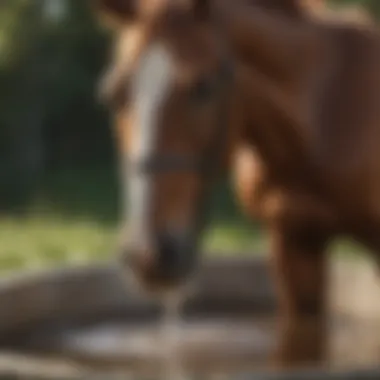
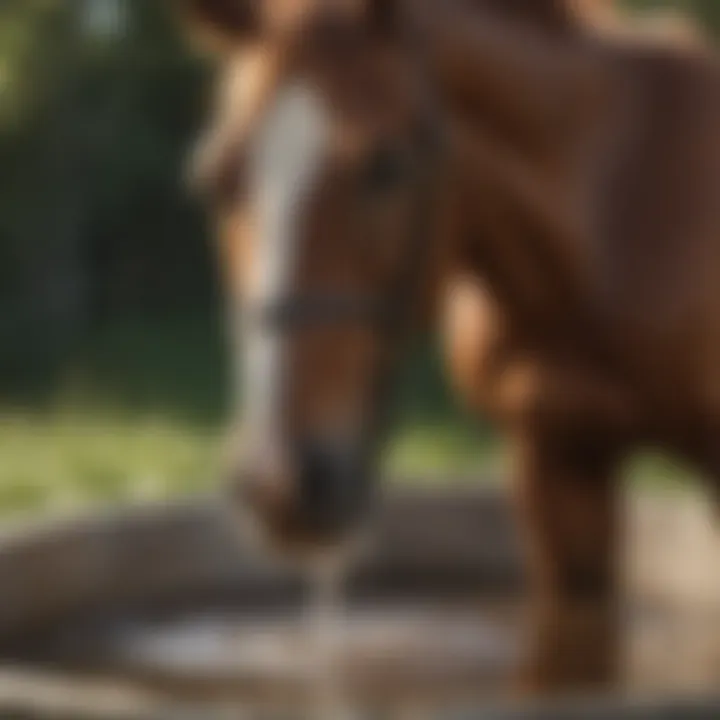
Applications in Equine Care
The role of the Zesterra equine tub in equine care is multifaceted. As a practical tool, it goes beyond basic hydration and feeds management. Understanding its applications allows equine professionals and enthusiasts to maximize horse health while addressing specific needs in daily management. From enhancing hydration strategies to monitoring health indicators closely, the Zesterra tub can be pivotal in promoting sustainable practices in horse care.
Hydration Strategies
Hydration is a fundamental aspect of equine management. The Zesterra equine tub addresses this need directly by providing a consistent and accessible water source for horses. Proper hydration is essential for maintaining physiological functions, supporting digestion, and optimizing nutrient absorption. By facilitating better hydration strategies, the Zesterra tub can prevent conditions resulting from dehydration, such as colic or kidney issues.
Moreover, the tub's design encourages horses to drink more water than traditional troughs. This is particularly beneficial during hot weather or after exercise, when fluid needs increase. Incorporating features like a larger capacity allows for less frequent refilling, ensuring that fresh water is always available.
Feed Management
Feed management is another crucial aspect of horse care that the Zesterra tub supports effectively. The tub allows for the simultaneous provision of feed and water, streamlining the feeding process. Equine nutritionists can adjust the amount and type of feed provided based on individual horse requirements.
By monitoring how much feed each horse consumes, caretakers can assess nutrient intake more accurately. This technique can highlight any changes in eating habits, which could indicate health issues or stress factors. Feeding management supported by the Zesterra tub can lead to improved overall health and performance outcomes.
Monitoring Health Indicators
Another significant application of the Zesterra tub is its role in monitoring health indicators of horses. Yearly check-ups and regular assessments are vital, but daily observations can provide immediate feedback. By observing horses while they use the tub, caretakers can note changes in drinking and eating behaviors.
For example, a sudden decrease in water consumption may signal an underlying issue, such as dental problems or illness. With real-time access to these health indicators, adjustments in care or diets can be made promptly, ultimately leading to better outcomes for the horse.
In summary, the Zesterra equine tub serves as a critical resource for effective hydration, feed management, and health monitoring. By addressing these key areas, equine professionals can enhance the overall well-being of their horses, leading to improved performance and longevity.
Benefits of Using the Zesterra Equine Tub
The Zesterra Equine Tub has become increasingly relevant in horse management. Its design caters to the multifaceted needs of equine care, which encompasses hydration and nutrient absorption. This section outlines pivotal benefits that justify its adoption among horse care professionals.
Enhancing Water Intake
Hydration is critical for the well-being of horses. Dehydration can lead to various health issues. The Zesterra Equine Tub encourages enhanced water intake through its thoughtful design. Its accessible and inviting shape allows horses to drink more freely, especially during warm months.
Horses that drink enough water show improved digestion and overall health. Increased water intake can aid in regulating body temperature, which is vital during hot weather. Proper hydration also affects metabolism, influencing performance levels and stamina.
"Water intake is fundamental for maintaining health and performance in horses."
Improving Nutrient Absorption
Good nutrition is essential for equine health. The Zesterra Equine Tub plays a role in improving nutrient absorption by ensuring horses are hydrated before and after meals. Adequate water intake can enhance the effectiveness of nutrient breakdown in the digestive system. When horses are adequately hydrated, they are more likely to utilize nutrients effectively, leading to better health outcomes.
Using the Zesterra tub can eliminate the risk of constipation and other digestive issues, which often arise from inadequate hydration. This serves to optimize the nutritional value of feed, ensuring that horses derive maximum benefits from their diets.
Facilitating Better Management Practices
Integrating the Zesterra Equine Tub into existing horse management strategies promotes better overall practices. This tub encourages regular monitoring of water and feed consumption, crucial for assessing equine health. The data gathered from using the tub can lead to informed decisions concerning dietary plans and hydration protocols.
Adopting the Zesterra Tub also emphasizes a more systematic approach to caring for horses. It offers a streamlined method to combine hydration and feeding effectively. When oversights in hydration are minimized, the number of veterinary visits and health issues may decrease, translating to cost savings for horse owners.
Implementing Zesterra Tub in Your Facility
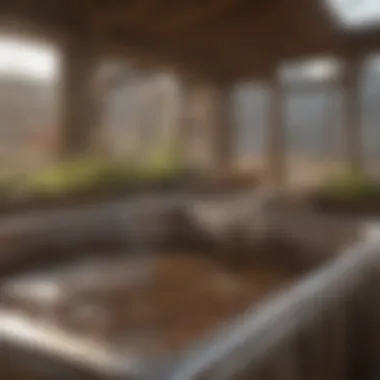

Implementing the Zesterra tub within your equine management practices can have a substantial impact on hydration and overall horse health. This section outlines important elements such as installation considerations, maintenance and care, and integration with existing systems to help ensure your investment is effective. Proper implementation not only maximizes the benefits of the Zesterra tub but also contributes to improved day-to-day management of your equine facilities.
Installation Considerations
Before installing the Zesterra tub, several factors must be considered. First, assess the space where it will be placed. The location should allow easy access for horses while also maintaining safety for both the animals and staff. Consider environmental factors such as shade and shelter to ensure optimal comfort for the horses. The tub should be anchored securely to prevent tipping and should have a stable surface to avoid spillage.
The plumbing setup is also essential. Ensure the water supply is adequate and the connections are leak-proof. Additionally, if the tub involves any electrical components for heating or water circulation, ensure that wiring is properly shielded from moisture to prevent hazards.
Maintenance and Care
Regular maintenance is crucial for the Zesterra tub to function optimally. The first step is frequent cleaning. Use gentle, non-toxic cleaners to prevent buildup of algae or bacteria that can harm horse health. It is also important to check for leaks or any damage regularly. Inspect seals and connections to ensure they are functioning correctly.
In addition to cleaning, regular water quality checks should be conducted. Water needs to be fresh and free from contaminants. Implement a schedule for these checks so that you can quickly identify and address any issues that arise.
Integration with Existing Systems
Integrating the Zesterra tub into your current management system can enhance efficiency and streamline processes. If you are using automatic waterers or feed systems, consider how the Zesterra tub can complement these systems. For instance, if your current setup includes a hydration management program, incorporate the Zesterra tub as part of that program. This allows for better tracking of hydration levels and ensures all aspects of horse care are cohesive.
Regular training sessions for staff using the tub can also facilitate smoother integration. Ensuring that they understand all functions of the tub enhances its usage and ultimately benefits horse health.
Key Takeaway: Proper installation, attentive maintenance, and seamless integration are vital for maximizing the Zesterra tub's potential in your equine management regimen.
Case Studies and Practical Examples
Case studies and practical examples offer invaluable insights into the real-world applications of the Zesterra equine tub. By looking at specific cases, one can grasp not only how the tub is utilized but also the direct impact it has on horse health and management practices. These examples serve to demonstrate the versatility of the Zesterra tub in various environments, be it a competitive setting, a training facility, or even at home.
In evaluating these case studies, we will focus on actionable insights—what successful implementations look like and what lessons can be drawn from those experiences. By examining these factors, we can better understand both the advantages and the challenges associated with using the Zesterra tub.
Successful Implementations
A number of equestrian facilities have successfully integrated the Zesterra tub into their routines. For instance, a large training barn in Kentucky reported a significant uptick in water intake among their horses after installing the Zesterra tub. The trainers noticed that horses were more inclined to drink when water was presented in a consistent and appealing manner. This adjustment led to improved hydration levels, particularly among young horses who are often finicky drinkers.
Additionally, other facilities have shared their experiences through forums such as Reddit. By discussing how they tailored the Zesterra tub to their specific needs, they highlighted some key modifications. For example, adjusting the height of the tub made it more accessible for smaller breeds and younger horses, enhancing user experience and engagement with the product. The feedback from these facilities emphasizes the importance of context in implementing this tool effectively.
Lessons Learned
While many successes have been documented, challenges have emerged as well. Some users initially experienced reluctance from the horses in adapting to the new fixture. It was found that gradual introduction of the Zesterra tub, rather than immediate replacement of traditional water sources, yielded better results. This strategy alleviated some of the initial apprehensiveness, allowing the horses to adjust more comfortably.
Moreover, maintenance has been emphasized frequently in feedback. Regular cleaning and upkeep are essential. For maximum efficiency, user experiences suggest establishing a routine maintenance schedule, which is crucial for ensuring the longevity of the tub and optimizing its benefits.
In summary, the case studies reveal that while the Zesterra equine tub holds promise for improving hydration and management practices, careful implementation and attention to detail can significantly enhance its effectiveness. By examining these practical examples, equine professionals and enthusiasts can refine their approach to using the Zesterra tub, making the most of what it has to offer.
Scientific Research and Evidence
The role of scientific research in understanding the Zesterra Equine Tub is crucial. It bridges the gap between theoretical concepts and practical applications. Focusing on empirical data, studies guide equine operators in effectively using the product. Through research, professionals can quantify benefits, set benchmarks, and establish best practices. This promotes informed decision-making, ultimately leading to improved horse management and health.
Studies on Hydration
Hydration is a key factor in maintaining the health of horses. Scientific studies have shown the relationship between adequate water intake and overall equine health. Research highlights that horses often do not drink enough water in traditional troughs. However, the Zesterra Equine Tub encourages optimal hydration through its design and functionality. Studies often utilize metrics like water consumption rates and horse behavior to gauge effectiveness.
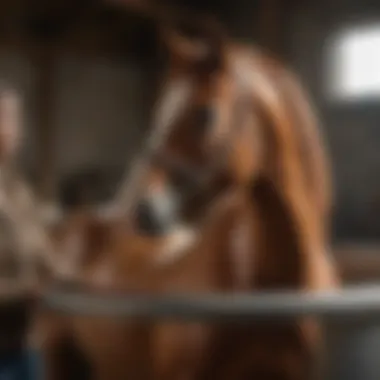
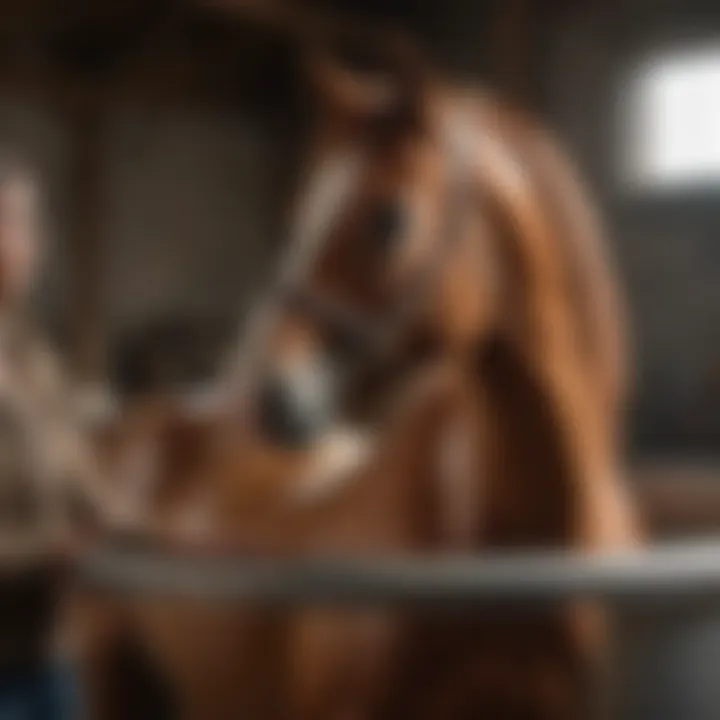
Key findings surrounding the Zesterra tub include:
- Increased Water Intake: Studies indicate that equines show a marked preference for drinking from the Zesterra tub compared to regular troughs.
- Behavioral Analysis: Evaluations reveal that horses exhibit less stress when accessing water from this specialized tub.
- Health Monitoring: Increased hydration reflects positively on blood viscosity, digestion, and thermoregulation in horses.
Nutritional Studies Related to Zesterra Tub
Nutritional studies concerning the Zesterra Equine Tub focus largely on the relationship between hydration levels and nutrient absorption. When horses maintain optimal hydration, their body can absorb nutrients more effectively. Research has documented how this affects energy levels and performance.
Findings often include:
- Enhanced Nutrient Absorption: Adequate water intake aids in the breakdown and assimilation of feed components.
- Digestive Health: Horses that have access to proper hydration tools tend to have improved gut health, reducing the risk of colic and other digestive issues.
Moreover, integrating hydration strategies with feeding practices is vital. The Zesterra tub supports this integration by making water easily accessible during feeding times. This holistic approach underscores the importance of both hydration and nutrition in equine care.
Challenges and Considerations
Understanding the challenges and considerations related to the Zesterra Equine Tub is essential for users in equine care. It is crucial to address common misconceptions and recognize the limitations of the product to ensure effective implementation and optimal outcomes. By highlighting these aspects, the article aims to inform equine farmers and enthusiasts about potential pitfalls and encourage informed decision-making regarding the tub's use.
Common Misconceptions
There are several misconceptions surrounding the Zesterra Equine Tub that need to be addressed. Some users may think that the tub can single-handedly resolve all dehydration and nutritional issues in horses. However, it is important to understand that while the Zesterra tub facilitates hydration and helps manage feed, it does not replace the need for a comprehensive dietary plan or proper veterinary care. Farmers must continue providing a balanced diet and monitor their horses' overall health.
Furthermore, some individuals believe that the Zesterra tub is only effective for specific types of horses. In truth, the tub’s utility spans various breeds and sizes. Whether for performance horses, pleasure horses, or those in training, the various features of the Zesterra tub can accommodate their unique hydration and feeding needs.
Limitations of the Product
While the Zesterra Equine Tub offers various benefits, it also has limitations that users must recognize. One significant aspect is the necessity for regular cleaning and maintenance. Build-up of residue or contaminants can affect the tub’s effectiveness, leading to poor hydration or nutrition. Users should establish a regular maintenance schedule to ensure optimal operation of the tub.
Additionally, the Zesterra Tub may not be appropriate for every environment. For example, in extremely cold climates, water can freeze, which may hinder the tub's functionality. Likewise, users in remote locations may face challenges concerning accessibility and water supply.
The cost of the Zesterra tub can also prove to be a limitation for some. Although the long-term benefits often outweigh the initial investment, smaller operations may find it challenging to allocate funds for its purchase. Such considerations must be factored into the decision-making process before acquiring the product.
Future Innovations in Equine Care
The landscape of equine care is evolving rapidly, particularly with the introduction of advanced technologies and innovative solutions. These innovations are critical because they not only enhance horse health but also streamline management practices for equine professionals and enthusiasts alike. In the context of the Zesterra equine tub, discussing future innovations allows us to anticipate how this crucial tool might evolve to better serve the equine community.
Technological advancements can improve functionality, increase efficiency, and potentially integrate with existing systems at farms. This progression in technology is aimed at optimizing horse care and health outcomes. Whether it’s through new materials, IoT integration, or software applications, the future holds much promise for enhancing equine care practices.
Emerging Technologies
Emerging technologies are paving the path for a more efficient approach to equine care. The rapid development of solutions such as artificial intelligence, machine learning, and data analytics is transforming various aspects of horseback riding practices and logistics.
Some key developments worth noting include:
- Telemedicine: Remote health monitoring using wearables can provide real-time data on horse health. This can lead to immediate interventions when necessary.
- Smart Devices: Innovations such as water sensors in the Zesterra tub can offer insights into hydration levels and encourage optimal water intake among horses.
- Mobile Apps: Management applications can help track nutrition, hydration, and health indicators. This facilitates better decision-making for horse care.
These technologies can create a connected ecosystem that supports the horse-owner relationship, promoting efficiency and well-informed management decisions.
Potential Improvements to Zesterra Tub
While the Zesterra tub already serves an important function in equine care, there are always areas for further enhancement. Identifying these potential improvements can greatly influence how the tub is utilized in practice. Some possibilities include:
- Enhanced Insulation: Improving the tub's ability to maintain water temperature can help ensure horses have access to fresh, palatable water regardless of environmental conditions.
- Modular Design: Creating components that can be easily added or replaced allows for customization based on specific needs, such as size adjustments or additional features for monitoring health indicators.
- Automated Monitoring: Integrating technology that tracks water consumption and sends alerts when abnormal patterns are detected could significantly boost the preventative care potential of the Zesterra tub.
"Incorporating advancements into the Zesterra tub can lead to greater compliance and better health outcomes for horses."
These enhancements could optimize functionality, contributing to the overarching goal of improving equine health and management practices. As we move forward, keeping an eye on both user feedback and technological advancements will be key for making meaningful upgrades.















